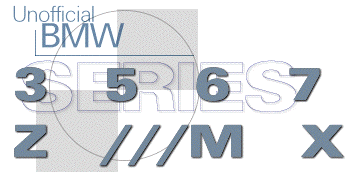|
Ron Stygar Carl Buckland Dale Beuning Forums Help
From digest.v7.n1060 Mon Feb 2 14:47:59 1998 There's been comments about "wide angle" aspherical convex mirrors that indicate that the underlying technology and engineering of the mirror is not well understood such as:
> I recently ordered these mirrors for my E28 (not heated). I was told As background all wide angle "aspherical" convex mirrors actually consist of two portions: • An inner spherical convex portion with a 55" to 100" radius of curvature (ROC) in which the driver views the near lane and sees an extended distance back up the road. Since the vehicles being viewed can be some distance back a relatively long ROC is important for large image size. • An outer reducing radius aspherical convex portion which expands the field of view from the normal 12° to 15° on the driver's side and 20° to 22° on the passenger side to about 35° to 40°. The design target of 35° to 40° is the amount of field of view necessary to see off the side of the car so that a driver can still see the last several feet of a car in the adjacent lane when the front foot or two comes into direct view turning the head no more than to look at the mirror. The outer aspherical convex portion reduces down to about a 10" ROC which considerably reduces the image size to about 3% of that seen in a flat mirror. The idea is that it's a good design trade-off to accept reduced image size in this outer portion in return for gaining an expanded field of view since the cars viewed in this portion are only 10' to 30' away and thus inherently large because near. In order for a driver to see directly rearward at the inside edge of the a mirror the mirror must be turned in towards the side of the car to an angle 1/2 the angle the head is turned to view the mirror (1/2 since there is both incidence and then reflection from the mirror surface). Depending on seat adjustment a driver typically turns their head about 35° to view the driver's side mirror and about 60° to 70° to view the passenger side mirror. Thus for the inside edge of the mirrors to view directly rearward (i.e., to see the side of the car as a reference point) the driver's side mirror must be turned in about 17° and the passenger side mirror must be turned in about 30°. The aspherical convex mirrors for each side are engineered to take the into account the extent to which each mirror must be turned into the vehicle for the side reference point orientation. The more turned in passenger mirror must have enough additional curvature at the outside edge compared to the driver's side mirror to provide the 35° to 40° field of view needed to eliminate the blind area. Thus circling back to the comment that started this note the use of a driver's side mirror for a RH drive vehicle on the passenger side of a LH drive vehicle will only provide a field of about 28°. An improvement over the OE spherical convex field of view of 20° to 22° but under what is needed to eliminate the blind area. The shape of the mirror on each side is symmetrical and thus physically interchangeable but the optical engineering does not provide the same performance. There have also comments which group all aspherical convex mirrors as interchangeable "wide angle" mirrors. There are substantial design difference and performance differences among them in two principal ways: • The several European versions are essentially generated by using an exponential equation for the reducing radius of the outside patron of the mirror. We use a "line-of-sight" design approach which uses what the driver see at various points scanning across the glass to drive what the curvature needs to be. That is the curvature design directly takes into account the subjective needs of the driver's eye focusing. • The second difference is the portions of the mirror comprising the inner spherical convex and outer reducing radius aspherical convex. European designs use about the outer 1/4 for warning zone (typically marked on the mirror with an etched dotted line). This approach places all the binocular optical load of the the different radius of curvatures (and thus different image sizes) seen by each eye into a narrow width of the mirror. Such an approach increases the focusing time to resolve and comprehend information in traffic. Our approach is to spread the aspherical portion and thus the optical load more gradually over about 1/2 the mirror. Mirrors using the European design approach were tried by a number of F1 teams and adopted by none when the driver's found that it took too long to comprehend information in the split seconds they had available to glance at the mirrors. We followed Villeneuve over from CART and as of the '98 season have been adopted by Williams, Jordan, TWR/Arrows, and Sauber for the performance required at that level of demanding driving. So then all "wide angle" mirrors are not the same and BMW didn't list the mirrors as interchangeable because they are only interchangeable in the sense of phsically fitting into the mirror heads. The optical performance needed on each side is quite different. Similarly, there are substantial differences between European and our mirror design as to driver eye comfort and quickness in comprehending information in heavily loaded urban expressway traffic. George Dalby |

